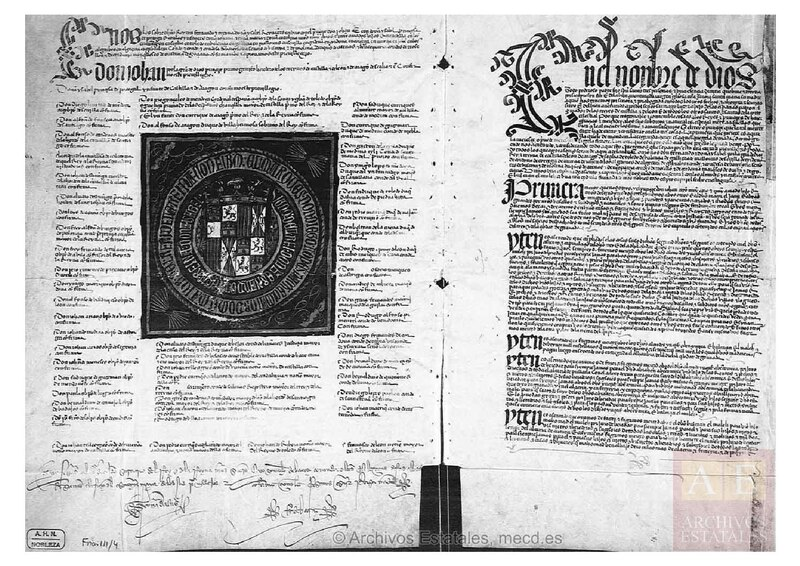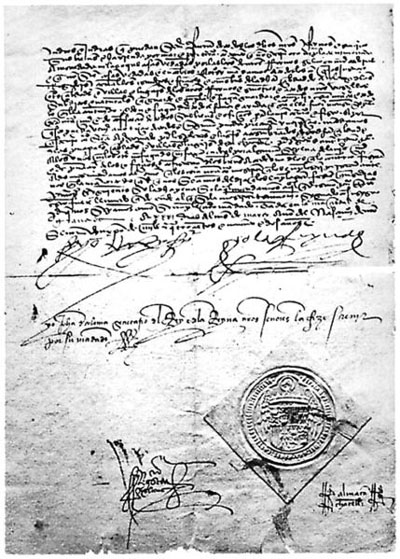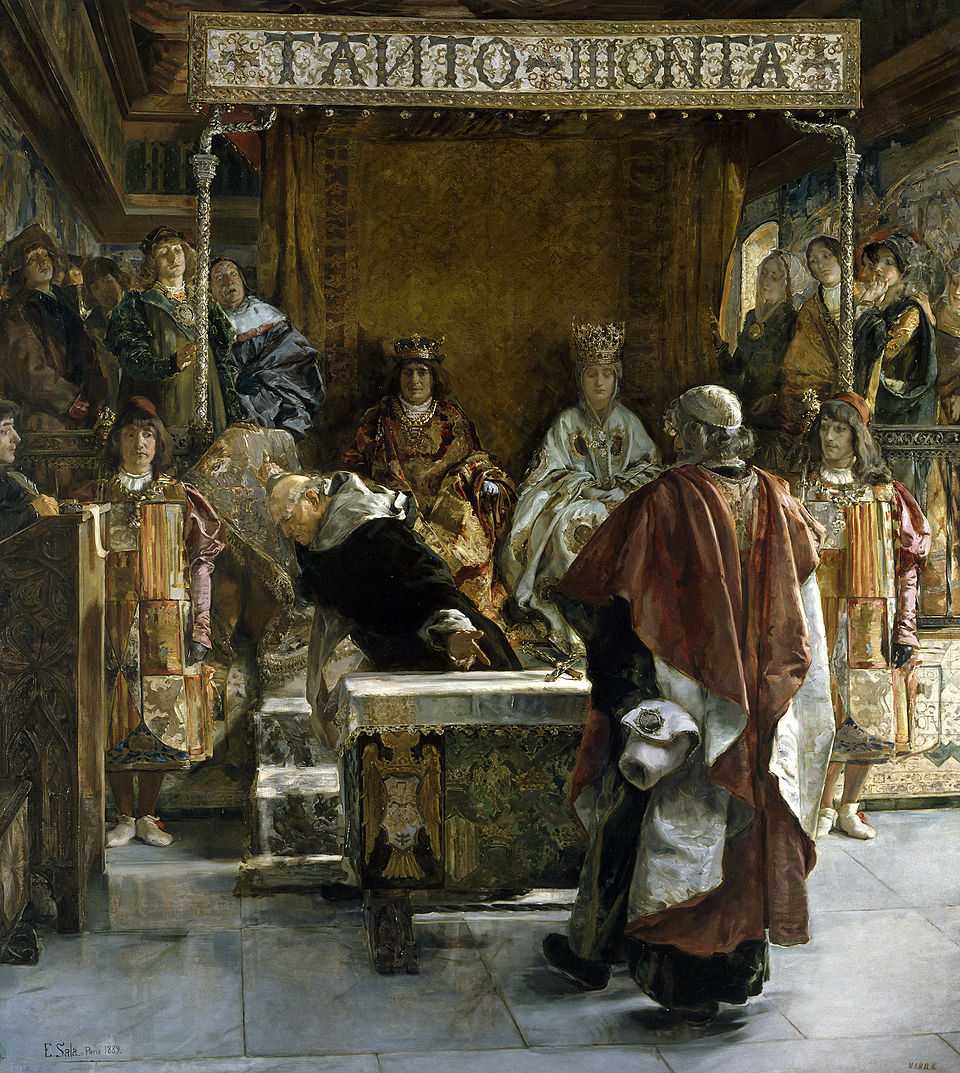IB Syllabus focus:
'Analysis of the terms of the Treaty of Granada and its implications for Muslims in Spain.
Examination of the Alhambra decree, its stipulations, and its immediate and long-term effects on Jews in Spain.
The political and social circumstances that led to the formulation of these agreements.'
The late 15th century bore witness to monumental changes in Spain, with the Treaty of Granada and the Alhambra Decree playing central roles in shaping the religious fabric of the country.
Treaty of Granada
Signed in 1491, the Treaty of Granada formalised the surrender of the Muslim kingdom of Granada to the Catholic Monarchs, Ferdinand and Isabella, thus marking the end of nearly 800 years of Muslim rule in Spain.

Facsimile of the 1491 Capitulaciones de Granada (Treaty of Granada), recording the conditions of surrender granted to the Muslim population, including protections for religion, property, and legal customs. The manuscript illustrates the legal framework that initially guaranteed autonomy and forbade forced conversions. Source
Terms of the Treaty
Freedom of Religion: One of the main clauses ensured that Muslims could freely practise their religion without interference, maintaining their mosques and observing Islamic festivities.
Protection of Property: Moors were guaranteed security concerning their properties, ensuring they wouldn't face confiscations or arbitrary seizures.
No Forced Conversions: The treaty explicitly stated that Muslims would not be forcibly converted to Christianity.
Release of Prisoners: All Muslim captives, irrespective of their status, were to be released unconditionally.
Retention of Weapons: While the city's fortifications were to be handed over, Moors could keep personal arms for protection.
Implications for Muslims
Initial Autonomy: Initially, the treaty allowed for a transition period wherein the Muslims in Granada enjoyed a sense of autonomy, continuing with their societal norms and structures.
Breach of Terms: Unfortunately, within ten years, Cardinal Cisneros violated the agreement by initiating forced conversions. This breach led to revolts, notably the First Rebellion of the Alpujarras.
Shift to Moriscos: As forced conversions grew, many Muslims became "Moriscos", or Christian converts. Yet, they were frequently treated with suspicion, often facing marginalisation.
Alhambra Decree
The Alhambra Decree, or the Edict of Expulsion, was issued in March 1492. It required the Jewish population to convert to Christianity or leave Spain within four months.

Manuscript of the Edicto de Granada (Alhambra Decree, 31 March 1492), ordering the expulsion of Jews who refused baptism and outlining restrictions on assets taken abroad. The document exemplifies late-medieval royal legislation used to enforce religious uniformity. Source
Expulsion: All Jews who refused to convert faced expulsion. The ultimatum was clear and resolute.
Sale of Property: While Jews were allowed to liquidate their assets, they were restricted in terms of what they could take with them – primarily excluding gold, silver, and money.
No Return: Expelled Jews faced severe penalties, including death, if they returned to Spain.
Effects on Jews
Immediate Impacts:
Mass Exodus: A significant proportion of the Jewish population, ranging from 130,000 to 200,000, chose exile over forced conversion, dispersing primarily across North Africa, the Ottoman Empire, and parts of Europe.
Economic Ripples: Spain's economy, particularly sectors where Jews played a pivotal role such as trade, finance, and medicine, experienced disruptions.
Long-term Impacts:
Diaspora's Legacy: The Sephardi Jews, as they came to be known, not only established thriving communities abroad but also became conduits for knowledge and culture.
Erosion of Heritage: Spain's rich Jewish history faced a gradual erosion with the absence of its primary custodians.
Reconciliation Attempts: Centuries later, the Spanish government made attempts to reconcile, with laws facilitating the return and granting of citizenship to the descendants of expelled Jews.
Circumstances Leading to the Agreements
Political Motivations
Unified Realm: By the end of the 15th century, Ferdinand and Isabella's vision was a united Spanish realm, consolidated under one faith. Eliminating religious minorities was seen as a step towards this.
Royal Authority: The monarchs believed that religious unity would strengthen their authority, minimising dissent and opposition.
Social Undercurrents
Religious Distrust: Centuries of intermittent warfare and religious rivalries had ingrained a deep-seated mistrust against non-Christians among the populace.
'Limpieza de Sangre': The idea of "blood purity" gained momentum, where having Christian lineage became a symbol of pride and status. This idea further alienated Jews and Muslims, even those who converted, as their "blood" was still seen as impure.
Influence of Religious Figures
Tomás de Torquemada: As the Grand Inquisitor, Torquemada was a dominant voice in the Spanish court. A fervent believer in religious unity, he championed the expulsion of Jews and the persecution of other non-Christians.

Emilio Sala’s The Expulsion of the Jews from Spain (1889) depicts Grand Inquisitor Tomás de Torquemada presenting the edict to Ferdinand and Isabella. While painted centuries later, the composition conveys the power dynamics and ideological fervor surrounding the decree. (Artistic reconstruction; not a contemporary image.) Source
In essence, the Treaty of Granada and the Alhambra Decree were more than mere legal documents; they were reflections of the socio-political currents of Spain in the 15th century. While they sought to create a united Spanish realm, they also sowed the seeds of cultural loss and diaspora that would resonate for centuries to come.
FAQ
The violation of the Treaty of Granada's terms, especially the forced conversions initiated by Cardinal Cisneros, led to deep-seated discontent among the Muslim population. Feeling betrayed, they orchestrated revolts against the Christian rulers. One of the most significant uprisings was the First Rebellion of the Alpujarras (1499-1501), where the Muslims of Granada rose against the Crown. Despite the rebellion being quelled, it highlighted the Muslims' deep resentment towards the breach of the treaty. The subsequent harsh reprisals by the Christian rulers further deepened the rift between the two communities.
While the Treaty of Granada initially protected the rights of Muslims, the subsequent breach and forced conversions transformed many Muslims into Moriscos. However, this new status didn't guarantee them peace. The Moriscos, being former Muslims, were viewed with suspicion by the larger Christian population, often accused of secretly practising Islam. This distrust culminated in the Morisco Revolt (1568-1571), post which their position deteriorated further. By the early 17th century, King Philip III decreed the Expulsion of the Moriscos (1609-1614), leading to the displacement of an estimated 300,000 Moriscos. Many perished during this exodus, while others integrated into North African societies, marking a tragic end to the once-thriving Muslim community in Spain.
While the Alhambra Decree was comprehensive in its aim to expel or convert Jews, there were nuances. Some Jewish families, particularly those of considerable wealth or influence, converted to Christianity and became "Conversos" to stay in Spain. These Conversos sometimes practised Judaism in secret. Furthermore, there were instances where influential Jews negotiated with local authorities for temporary stays or deferrals in the deadline for departure. However, such exceptions were scarce, and most Jews faced the grim choice of conversion or exile, with no genuine assurance of their safety even after converting.
The Sephardi Jews, having been deeply integrated into Spanish society for centuries, carried with them an amalgamation of Spanish and Jewish cultures. When they settled in regions like North Africa, the Ottoman Empire, and parts of Europe, they introduced elements of Spanish language, arts, cuisine, and other cultural norms. For instance, Ladino, a Judeo-Spanish language, emerged and flourished in these new lands. Through their trade, scholarship, and community interactions, Sephardi Jews became instrumental in disseminating Spanish culture and traditions, embedding it into the cultural tapestry of their new homes and playing a role in global cultural exchange.
The Mudejars were Muslims who lived under Christian rule in areas of Spain that were reconquered by the Christian kingdoms before the Treaty of Granada. They retained their Muslim identity and practices, often serving as vital economic contributors. Specialised in various trades like agriculture, carpentry, and masonry, they were responsible for the architectural style known as Mudejar, blending Islamic and Christian designs. Their presence was a testament to the complex coexistence of religions in Spain, but they also faced various degrees of discrimination, varying from one Christian kingdom to another. Their experiences foreshadowed the challenges that would soon be faced by Muslims post the Treaty of Granada.
Practice Questions
The Treaty of Granada was initially a beacon of hope for Muslims in Spain, guaranteeing religious freedom and protection of property. It promised a sense of autonomy and peaceful coexistence. However, this hope was short-lived. Within a decade, Cardinal Cisneros disregarded the treaty's terms, initiating forced conversions. This blatant breach led to significant discontent, manifesting in revolts such as the First Rebellion of the Alpujarras. Consequently, many Muslims were coerced into becoming "Moriscos", facing societal marginalisation despite their conversions. Thus, what began as a treaty of tolerance quickly degenerated into a period of religious persecution.
The Alhambra Decree's most enduring impact was the creation of the Sephardi Jewish diaspora. As Jews were expelled from Spain, they carried with them their rich traditions, culture, and knowledge, establishing thriving communities in regions like North Africa, the Ottoman Empire, and parts of Europe. In doing so, they acted as ambassadors, enriching their new homes with the profound cultural heritage of Spain. However, Spain itself experienced a loss. The expulsion eroded a significant part of its diverse history, with the absence of its Jewish custodians leading to a loss of cultural richness that had once defined the Iberian Peninsula.

